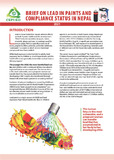Please use this identifier to cite or link to this item:
https://hdl.handle.net/20.500.14356/757Full metadata record
| DC Field | Value | Language |
|---|---|---|
| dc.contributor.author | Sah, Ram Charitra | - |
| dc.date.accessioned | 2021-11-25T05:38:35Z | - |
| dc.date.accessioned | 2022-11-08T10:19:57Z | - |
| dc.date.available | 2021-11-25T05:38:35Z | - |
| dc.date.available | 2022-11-08T10:19:57Z | - |
| dc.date.issued | 2021 | - |
| dc.identifier.citation | Sah, Ram Charitra, Study of Lead in Spray Paints, Nepal, Center for Public Health and Environmental Development (CEPHED). October 2021 | en_US |
| dc.identifier.uri | http://103.69.126.140:8080/handle/20.500.14356/757 | - |
| dc.description.abstract | Lead is a toxic metal that causes adverse effects on both human health and the environment. “Paint” includes varnishes, lacquers, stains, enamels, glazes, primers, or coatings used for any purpose. Paint is typically a mixture of resins, pigments, fillers, solvents, and other additives. “Lead paint” is a paint in which one or more lead compounds have been added. While lead exposure is also harmful to adults, lead exposure harms children at much lower levels, and the health effects are generally irreversible and can have a lifelong impact | en_US |
| dc.description.sponsorship | Wolrd Health Organization. | en_US |
| dc.language.iso | en_US | en_US |
| dc.publisher | Center for Public Health and Environmental Development (CEPHED) | en_US |
| dc.relation.ispartofseries | RES01040;RES01040-SAH-2021 | - |
| dc.subject | Lead Paint | en_US |
| dc.subject | Lead anti-corrosive agents | en_US |
| dc.subject | Lead driers | en_US |
| dc.subject | National Paint | en_US |
| dc.subject | Multination Paint | en_US |
| dc.subject | Lead driers | en_US |
| dc.title | Brief on lead in paints and compliance status in Nepal | en_US |
| dc.type | Technical Report | en_US |
| Appears in Collections: | NHRC Research Report | |
Files in This Item:
| File | Description | Size | Format | |
|---|---|---|---|---|
| RES01040-SAH-2021.pdf | Download Full Text Report. | 1.68 MB | Adobe PDF |  View/Open |
Items in DSpace are protected by copyright, with all rights reserved, unless otherwise indicated.
